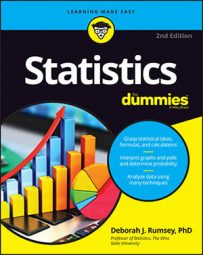The most well-known and loved discrete random variable in statistics is the binomial. Binomial means two names and is associated with situations involving two outcomes; for example yes/no, or success/failure (hitting a red light or not, developing a side effect or not). A binomial variable has a binomial distribution.
A random variable is binomial if the following four conditions are met:
There are a fixed number of trials (n).
Each trial has two possible outcomes: success or failure.
The probability of success (call it p) is the same for each trial.
The trials are independent, meaning the outcome of one trial doesn't influence the outcome of any other trial.
Let X equal the total number of successes in n trials; if all four conditions are met, X has a binomial distribution with probability of success (on each trial) equal to p.
The lowercase p here stands for the probability of getting a success on one single (individual) trial. It's not the same as p(x), which means the probability of getting x successes in n trials.
Here's an example: You flip a fair coin 10 times and count the number of heads (X). Does X have a binomial distribution? You can check by reviewing your responses to the questions and statements in the list that follows:
Are there a fixed number of trials?
You're flipping the coin 10 times, which is a fixed number. Condition 1 is met, and n = 10.
Does each trial have only two possible outcomes — success or failure?
The outcome of each flip is either heads or tails, and you're interested in counting the number of heads. That means success = heads, and failure = tails. Condition 2 is met.
Is the probability of success the same for each trial?
Because the coin is fair, the probability of success (getting a head) is p = 1/2 for each trial. Condition 3 is met. Note, that you also know that 1 – 1/2 = 1/2 is the probability of failure (getting a tail) on each trial.
Are the trials independent?
You assume the coin is being flipped the same way each time, which means the outcome of one flip doesn't affect the outcome of subsequent flips. Condition 4 is met.
Because the random variable X (the number of successes [heads] that occur in 10 trials [flips]) meets all four conditions, you conclude it has a binomial distribution with n = 10 and p = 1/2.

